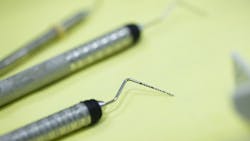Staff Rx: How can I convey the importance of periodontal maintenance appointments?
Dear Dianne,
One of the most difficult aspects of treating my periodontal patients is getting them to understand the importance of being seen every three months. They often throw out excuses, such as, “My insurance will only pay for twice-a-year visits.” What I’ve noticed is that my patients who come every three months fare better than those who do not come in as scheduled. The business desk complains about high no-show rates with maintenance patients. How can I help patients understand the importance of maintenance and achieve a better show rate?
Abbie, RDH
Dear Abbie,
The phase of treatment following definitive periodontal therapy called “periodontal maintenance” is an extremely important part of helping periodontal patients achieve long-term success. I could quote a number of excellent studies that prove the value of maintenance, but the conclusion is consistent: regular maintenance visits are associated with lower levels of tooth loss. While we generally think of maintenance visits at three-month intervals, Farooqi et al. posited that the “optimum frequency” is not clear.1 Some of the advanced cases we see should probably be seen more frequently than every three months for periodontal debridement, at least for the first year following definitive therapy. Some patients may be able to maintain good periodontal health with fewer frequent maintenance visits.
The problem with getting patients to understand the frequency of care issue may be rooted in the way it is communicated to them. Allow me to make a few suggestions.
First, I would like to suggest that you change your descriptive phrase from “periodontal maintenance” to something that denotes more importance, such as “disease control visit.” Another phrase you will see in much of the peer-reviewed literature is “supportive periodontal therapy,” often abbreviated SPT. Many of us think of “maintenance” as something we do to our cars, like changing the oil. Why would we use a term that may have a low-value connotation? What we are attempting to do in this phase of therapy is control the disease from causing further destruction and reduce the probability of reinfection. Here’s an example of a conversation I would have with a patient after I finish the definitive periodontal debridement (root planing and scaling) phase:
“Mr. Patient, we’ve made good progress so far, and we want to continue moving in the right direction. We have completed the definitive therapy phase, and now we’re moving to the next phase, which is disease control. This critical phase will have a great impact on your long-term success. We know from treating many patients like you that disease control is possible only if we see you for professional care every three months for the next year. At the end of the year, we will reevaluate everything and decide if we can lengthen the time between visits.”
Your patient needs to understand the difference between completion of the first phase and progressing to the second phase, which is disease control.
“You did not get this disease overnight, and it will take some time to get everything stable. The goal of supportive care is to keep the pathogen counts as low as we can. Without disease control visits, the pathogens can repopulate rapidly, and the disease can come roaring back.”
Sometimes patients are dependent on insurance and their objection has to do with third-party benefit limitations. The patient may say, “But my insurance will only pay for me to come in every six months.” Instead of saying negative things about a patient’s benefits, it’s better to take a positive spin on the matter:
“We are happy that you have benefits to use. But typical benefits only cover basic things. Your periodontal condition is not basic, and for the best long-term outcome, you will need to come in every three months. We hope to get the disease under control, but we won’t know if it’s controlled until the first year has passed. So, you will have some out-of-pocket costs for that part of your care.”
If you are seeing a high no-show rate, it is possible that your periodontal patients simply do not see the value in the service. I mention this because sometimes they can’t tell the difference between a regular cleaning and a maintenance appointment. Believe it or not, I’ve had patients write me complaining about feeling ripped off because they were charged a significantly higher fee for a D4910 procedure compared to a D1110 procedure, when they didn’t perceive any difference whatsoever. When I receive emails like that, I refuse to stand in judgment, and often recommend they take the matter up with the dentist. What I know is this: patients are not stupid. If they don’t perceive any difference, then maybe there isn’t any difference, and that’s a shame.
Patients should be able to tell a difference between a prophy (a preventive procedure) and a disease control visit (a therapeutic procedure). Obviously, there are a few common components involved, such as medical history update, oral cancer exam, restorative and soft tissue assessments, removal of hard and soft deposits, and polish. However, a disease control visit should have an antimicrobial component with medicaments not used with prophy patients. Additionally, there should be heavy utilization of power scalers and hand instruments designed for deep pockets. There should always be assessment of home care and modifications as needed. You may see a need for anesthetics, site-specific therapies, systemic antibiotics, or pathogen analysis. If inflammation persists, you have not been successful, and referral should be the next step. In fact, if you do not see steady improvement following definitive periodontal debridement, referral is the appropriate action.
One more thing that may be influencing a high no-show rate is patient discomfort. Periodontal patients may have tissues that are tender or root surfaces that are hypersensitive. Make sure you are doing everything in your power to keep patients comfortable while they are in your chair.
Improving your communication with patients can go a long way toward helping them understand the importance of the second phase of periodontal care. If you can implement some of my suggestions, I believe you will have success in reducing your no-show rate.
All the best,
Dianne
Reference
- Farooqi OA, Wehler CJ, Gibson G, Jurasic MM, Jones JA. Appropriate recall interval for periodontal maintenance: A systematic review. J Evid Based Dent Pract. 2015;15(4):171-181. doi:10.1016/j.jebdp.2015.10.001
Dianne Glasscoe Watterson, MBA, RDH, is a consultant, speaker, and author. She helps good practices become better through practical analysis and teleconsulting. Visit her website at wattersonspeaks.com. For consulting or speaking inquiries, contact Watterson at [email protected] or call (336) 472-3515.
About the Author
Dianne Glasscoe Watterson, MBA, RDH
DIANNE GLASSCOE WATTERSON, MBA, RDH, is a consultant, speaker, and author. She helps good practices become better through practical analysis and teleconsulting. Visit her website at wattersonspeaks.com. For consulting or speaking inquiries, contact Watterson at [email protected] or call (336) 472-3515.
Updated June 30, 2020

